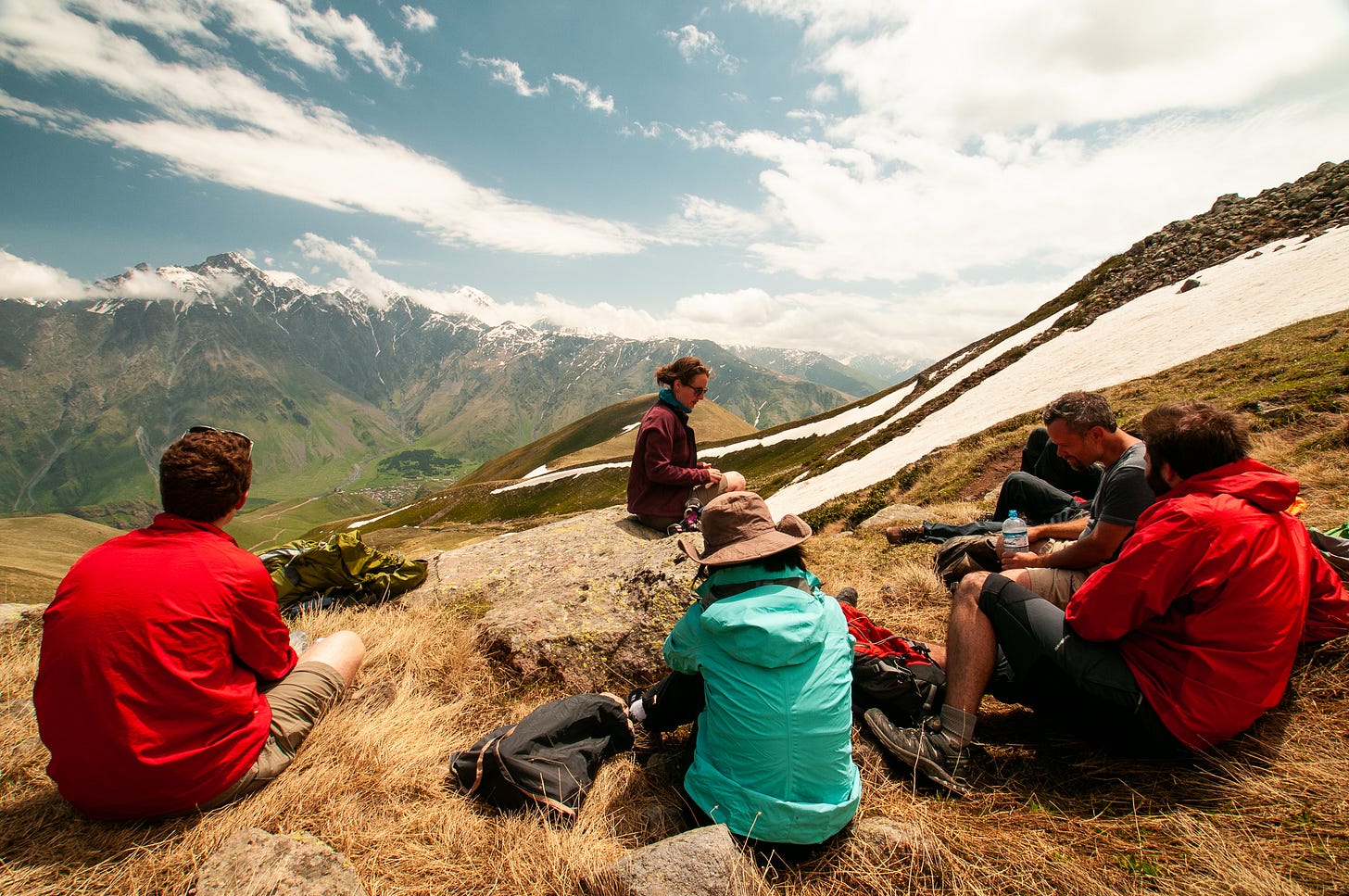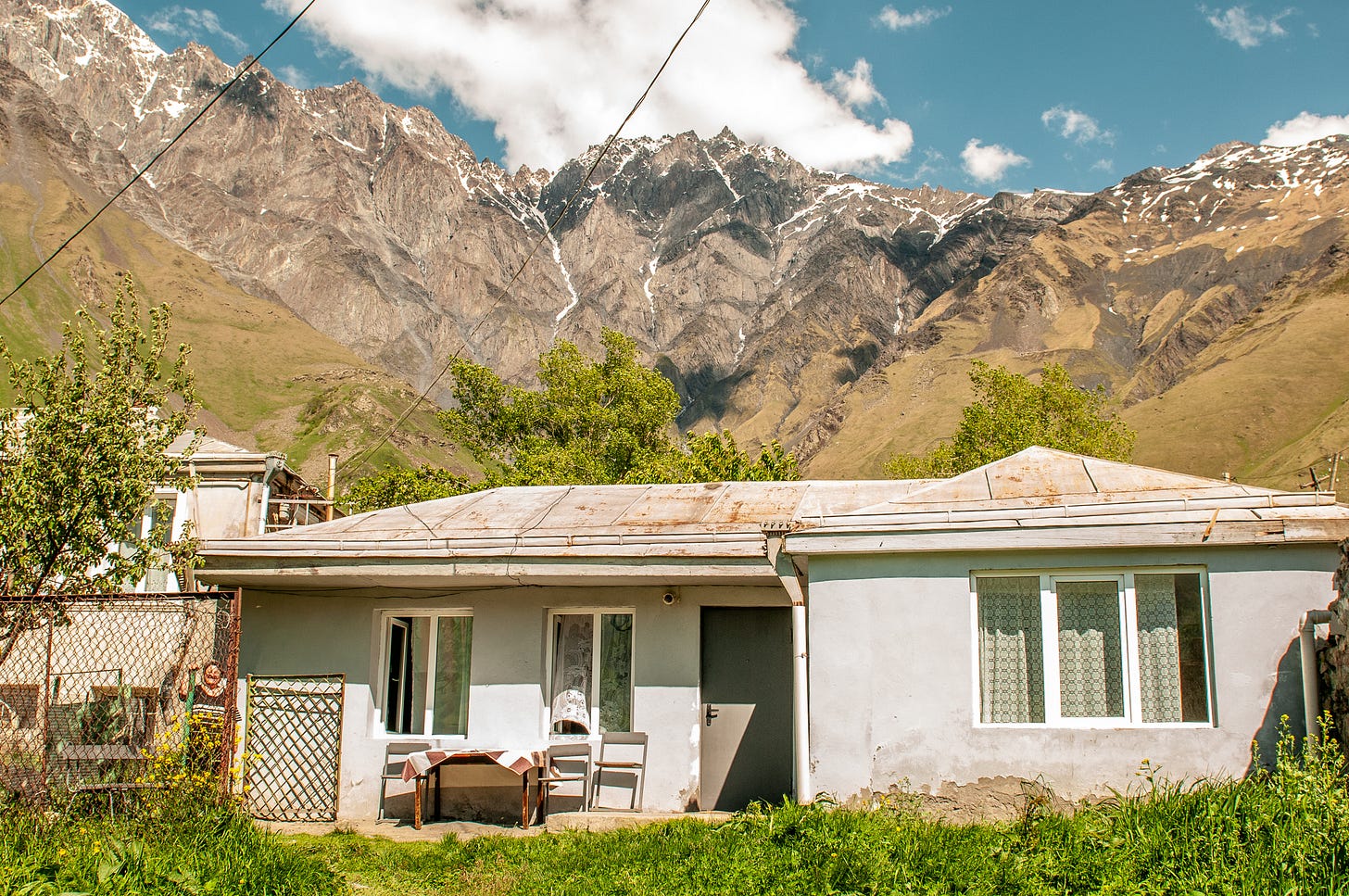I’ve been thinking about sunburns a lot lately, and it’s only in part because the sun has gone from being an absent friend to that overbearing guest who doesn’t know when they’ve overstayed their welcome. By now, even most non-writers have heard the old saw, write what you know. Though I’m not going to dive into how misunderstood and misapplied that bit of advice often is, I do know a few things about sunburns, so naturally when my naïve traveling librarian set out on his first adventure, I felt it only natural to treat him to a little abuse, I mean, character development at the hands of the sun.
The specific sunburn I’ve been thinking about happened on the other side of the world in a little Georgian town (properly a townlet with a population of roughly 1,400 people) by the name of Stepantsminda, formerly and more popularly known as Kazbegi. Like most mountainous regions in Georgia, getting there is a bit of an adventure in and of itself. Public transportation is limited to run-down microbuses that leave when they’re full (we sat around for three hours for ours to fill up), and the roads are often little more than rough dirt tracks carved into mountainsides. When the glorified minivan isn’t on the verge of overheating as it grinds its way uphill, further delays come in the form of rockslides and herds of goats who couldn’t give a damn about our desire to get to our destination. Stepantsminda is only 157 kilometers (98 mi) from the capital of Tbilisi, but it might as well be fifty times that distance for how inefficient the journey was1.
Other than the natural beauty of the region, the main attraction is the Gergeti Trinity Church, perched at 2,170 meters (7,120 feet) above sea level and 430 meters above the town. I’m sure it’s entirely possible to hire a car to drive up to the church, but we’d already discussed hiking up to the church and into the mountains beyond with some of the other travelers we’d met on the bus ride into town, so early the next morning we set off on our little trek.
The thing about the mountains is that you can be both very cold and very warm depending on how much you’re moving and how strong the wind is blowing. I’d decided to wear shorts, as had several others from our little band of adventurers, but as we approached the perennial snowfields in the upper reaches of Mount Kazbek, it became cold enough that I pulled an insulated jacket on over my wool sweater and wrapped a scarf around my face to protect from the whipping wind that chafed the exposed skin of our faces. Mount Kazbek’s summit sits at a lofty 5,054 meters (16,581 ft) above at sea level, though we decided to call it a day at the snow line just past the 3,000-meter (9,842 ft) mark. Another fun fact about the mountains is that UV exposure increases by 4% with every 1000 ft elevation gain2. So we’re talking 28% higher risk of a sunburn at our starting point for the day up to nearly 40% higher by the time we stopped for lunch.
This is where I’d love to plead ignorance, but I’ve read enough mountaineering memoirs to know that the risk of sunburns is way higher in the mountains. Since this was back in 2012 and just one stop among many on our 7-week trip around Georgia, I don’t really remember the details of the dinner we’d had the night before, but Georgians have a strong drinking culture so there’s a very good chance I’d been indulging in local wine and spirits the previous evening. Whatever the case, I hiked my dumb ass a thousand meters up the side of a mountain with the sun blazing on the back of my legs for several hours.

Did you know the back of the knee is properly called the popliteal fossa? I didn’t until I just looked it up right now, and that knowledge has done absolutely nothing to blunt the memory of how excruciatingly painful it is to sunburn what most of us just call the kneepit. I realized I was burning when I felt fire in my kneepit with each descending step from our high point, but it wasn’t until I got back to our little guesthouse that I realized just how badly I’d messed up. My leg had gone straight past apple-red and settled into the vibrant purple of a fresh bruise. For most of that afternoon, all I could do was strip down to my underwear and lie facedown on the bed while trying not to cry into my flimsy excuse for a pillow. With only my trauma to blame for the haziness of memory that surrounds the rest of that day, I do know that at some point I struggled into pants so the sun wouldn’t touch my skin, then shuffled painfully down to the only pharmacy in town. Earlier in this story, I wrote ‘we’, because I was traveling with my then-girlfriend, but the reason she didn’t just run down to fetch me some aloe vera lotion is that a lot of Georgians don’t speak any English. The only way I was getting help from these ladies at the pharmacy was by going down there and showing them my poor, abused legs while miming violent attacks from the sun’s rays until they realized what I needed.
Which they apparently believed was SPF 15 sunscreen.
“How do you think you say, ‘it’s way too late for that’ in Georgian?” I asked my girlfriend before turning back to the pharmacists and emphatically shaking my head and then acting out visible relief from pain until understanding dawned and they brought me a little white container of ointment with a label written entirely in Georgian script. After a bit of mental currency exchange math, I realized it only cost about $3 CAD, and figuring it was the best I was going to get, I decided it was worth a shot. I wish I’d taken a photo of the label so I could translate it now, but unsurprisingly I was in so much discomfort I basically didn’t take any photos until I was back in Tbilisi a couple of days later. If you’re not familiar with Georgian script, here’s what I am a big dumb idiot who should never go anywhere without sunscreen looks like in Georgian:
მე ვარ დიდი სულელი იდიოტი, რომელიც მზისგან დამცავი კრემის გარეშე არსად არ უნდა წავიდეს
So yeah, no way I was making any sense of that label. The only way I can describe this stuff is that it was thick, greasy, and reeked of sheep. Back in high school, one of my closest friends had grandparents who owned sheep. I visited once and spent an entire day helping out with the sheep, so I have a pretty good idea of what sheep smell like. My best guess is that the ointment was primarily lanolin (a wax secreted by the sebaceous glands of wool-bearing animals) but at the time it smelled and felt a lot like smearing sheep fat on my legs. There was no noticeable pain relief, it stained my clothes, and made my legs stick to the sheets at night. Whatever it was, it worked. Miraculously, my skin didn’t blister or peel even a little bit. The angry purple faded to an only slightly-annoyed red, which eventually tamed itself into the ruddy blotchiness that’s as close as I ever come to getting a tan.
And that’s not my worst sunburn story by a long shot, though I’m not sure if burning the soles of my feet so badly on hot sand I couldn’t walk for several days counts as a sunburn? Anyway, that’s a story for another time. The reason I’ve been thinking about this particular sunburn is that the Library on which The Traveling Librarian stories are based is situated in a mountainous location that’s very much inspired by Stepantsminda and the stunning location of the Gergeti Trinity Church. I may not be a pasty librarian who spends too much time inside (though I do spend too much time inside nowadays), but as someone who has no excuse not to know better, I’m still capable of making idiotic decisions that leave me sunburnt and suffering, just like a certain fictional librarian venturing out into the world for the first time.
Until next time, I’ll see you among the stacks where I’m hiding my fair skin from the ravages of the sun rather than putting on a bit of sunscreen.
-mark
I wonder if the roads have gotten any better in the intervening years. Have you been? How was the trip?
Source: wikipedia.org/wiki/Sunburn








Blame it on Raffi not putting a proper warning on this Oh, Mr. Sun, Sun, Mr. Golden Sun
Please shine down on me song that was burned into my memory from time spent with you when you were a younger and impressionable you.